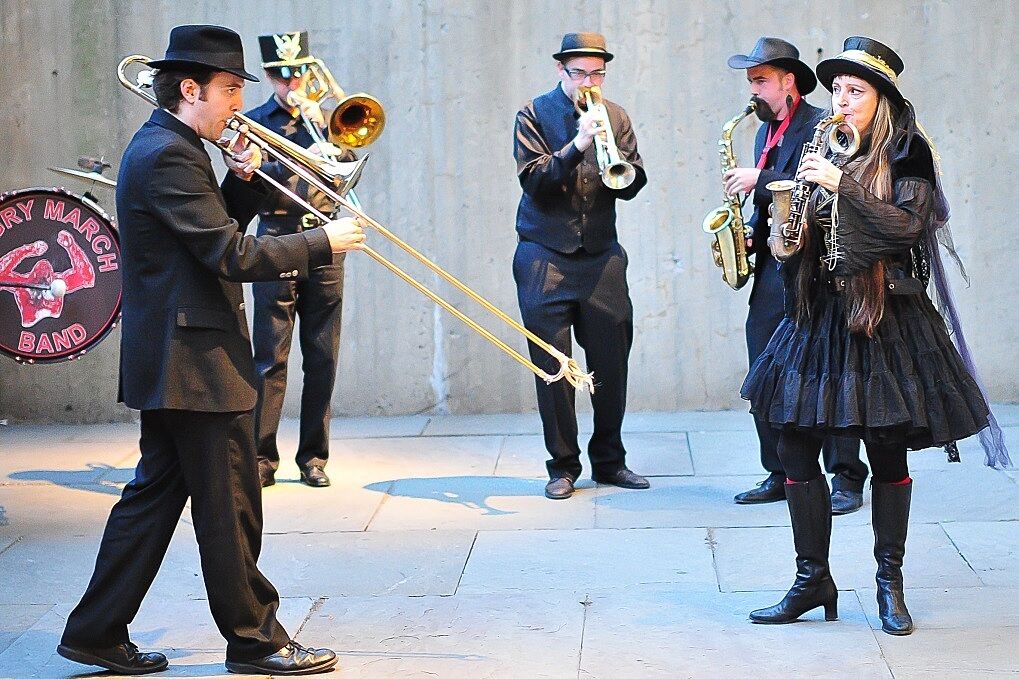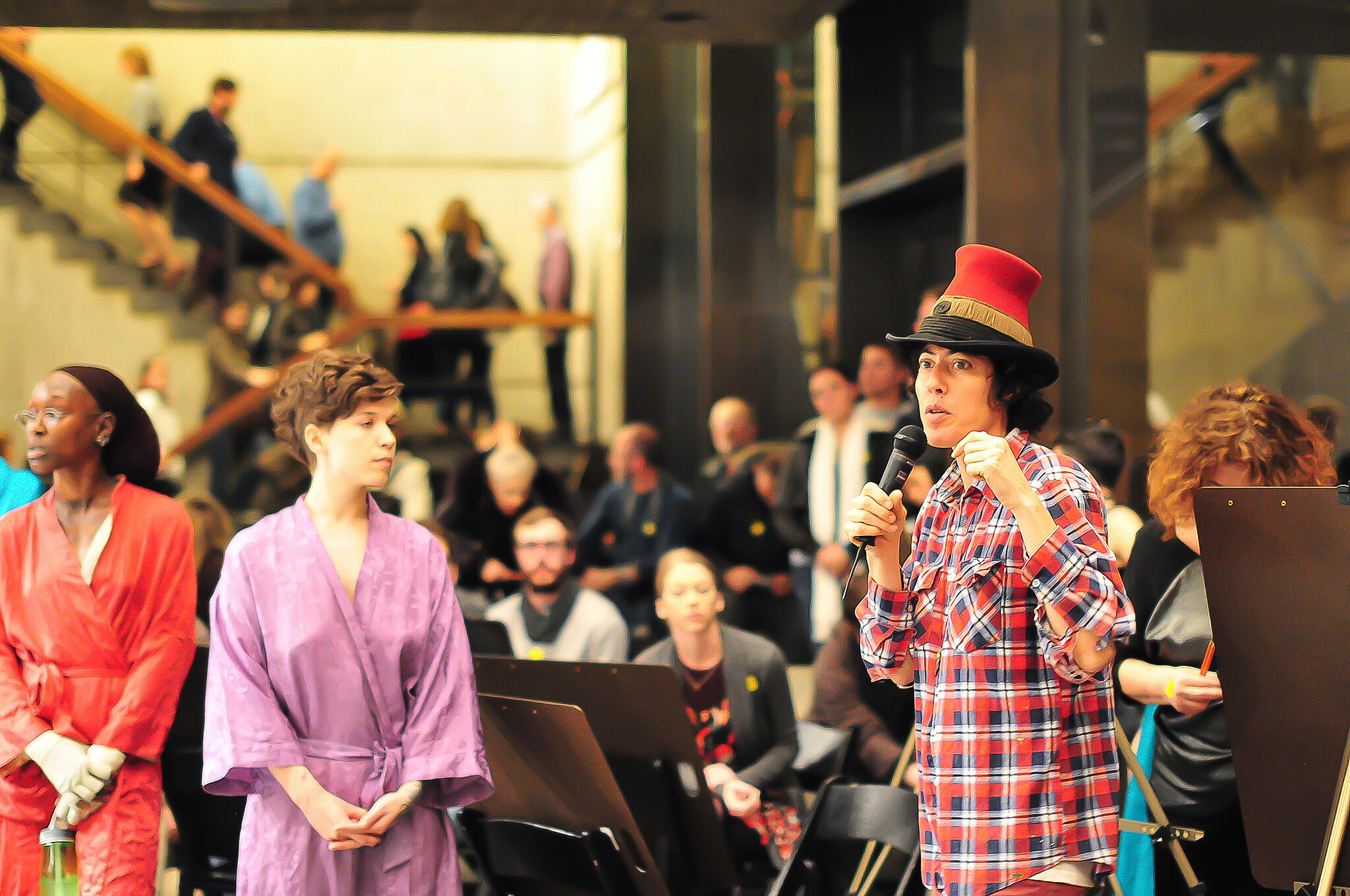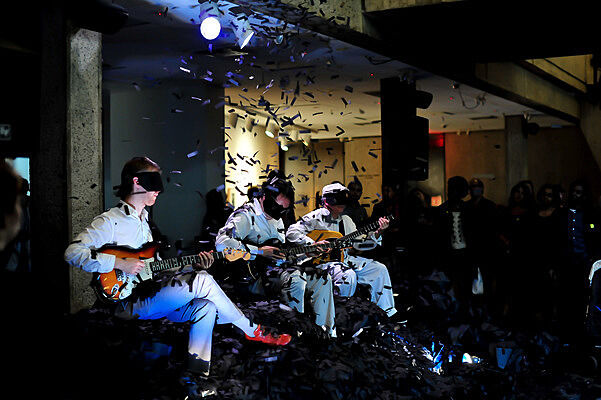Permeable Programs
Aug 25, 2014
In preparation for the Whitney’s move to the Meatpacking District, I have been archiving many photographs and audio clips from past public programs. This has allowed me to track the development of the Museum’s public programs since the 1980s, and appreciate how the architecture of a museum can impact how artists work and how audiences experience live events.
From famous artists to influential critics and art historians, the Whitney’s current building designed by Marcel Breuer has hosted them all, but the nature of the programs has shifted over time to take full advantage of the dynamic between passersby and the fortress-like space of the museum. In 1965, Breuer wrote an essay entitled “The Architect’s Approach to the Design of the Whitney Museum,” in which he stated that the building should “transform the vitality of the street into the sincerity and profundity of art.” The results often created a sharp contrast between the interior galleries and the commercial bustle of Madison Avenue. But Breuer also included “a sunken sculpture court. . .[which] shows the glass front of the lobby facing Madison Avenue, and the sculpture gallery which provides contact with the street and with the passerby.” In recent years, more and more artists have found ways to make connections between the museum and its surrounding environment (an approach that Renzo Piano’s design for the Whitney’s new building will encourage).
One program that stands out for using the architecture of the Breuer building in a unique way is Joanna Malinowska’s Fieldwork event, part of a series of public programs in conjunction with the Biennial 2012 exhibition. Malinowska’s sculptures and painting in the exhibition explored her interest in cultural anthropology. Given the opportunity to execute an original program of her own design, Malinowska staged a performance with the Hungry March Band. The band split into two groups, and each started playing completely separate pieces—one outside the building on the sidewalk, and one in the Whitney’s Sculpture Court.
Both groups marched into the Lower Gallery, colliding physically and musically to represent the amalgamation of different cultures. Following this performance, participants Skyped with protestors who were marching against the imprisonment of Leonard Peltier, a Native American activist who allegedly murdered an FBI agent. Finally, the audience listened to a performance by Masami Tomihisa on a toy piano, before joining her in an eight-minute howl at the Moonlight Sonata. With the freedom to engage her viewers in a multifaceted experience beyond her artwork, Malinowska utilized the building’s transparency to host live rituals and engage their versatile meanings based on context.
An event called Figure Drawing Atelier, hosted by 2012 Biennial artist Nicole Eisenman also foregrounded how the Whitney’s current building has acted as a creative space for live events. This program mirrored Eisenman’s Biennial contribution, The Drawing Class (2011), and gave participants the chance to take a figure drawing class and draw from live models in the Lower Gallery. The activity incorporated the artist’s practice of a “drawing group” she holds with friends, as well as the eclectic playlist of Eisenman’s own music that she often plays in the studio. This was a new experience for all parties involved—including the passers-by on Madison Avenue who could look into the Museum and see nude models posing for an audience of both experienced artists and figure-drawing novices.
Another program that showcased the Breuer building’s architecture (and demonstrated the Whitney’s experimental approach to public programs) was William Pope.L’s event Burying the Blues in 2013. In conjunction with the exhibition Blues for Smoke, Pope held a performance in the Lower Gallery and invited his audience to “bury the blues.” He literally buried his performers by raining black confetti from the Museum Lobby onto blindfolded guitarists in the Lower Gallery below. The audience was invited to write letters to the deceased bluesmen—with paper, envelopes, and stamps provided. Pope’s installation and performance art in the exhibition dealt with race and inequality, and by working with guitarists Richard Robinson, Kenny Wessel, and Nir Felder, he gave his audience a performance that challenged them to “say goodbye” to the blues aesthetic, including music, art, language and geography, and the negative history that it holds.
Watch a video about William Pope.L’s performance Burying the Blues.
The possibilities for Public Programs will continue to grow with the opening of the Whitney’s new building. Architect Renzo Piano’s design for the Whitney on Gansevoort Street includes natural light and enormous gallery spaces, as well as outdoor terraces and an exterior staircase that will help to bring the surrounding neighborhood into the galleries. These spaces that connect the Museum interior with its surrounding neighborhood will inspire more experimental public programs, and will give artists even more flexible spaces to interact with their audiences.
Find out more about the Whitney’s Public Programs.
By Danielle Leventhal, Public Programs Intern



